National treasure: Shaanxi cultural relics
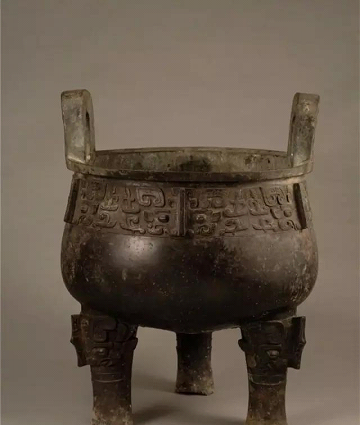
Yuding: a cooking vessel from the Western Zhou Dynasty
Yuding, cast in the period of Emperor Kang of the Western Zhou Dynasty, is the most valuable cultural relic in the Shaanxi Historical Museum. With delicate ornamentation lines carved on the outside and 28 inscription characters cast inside of the vessel and following the style of the round ding of the Shang Dynasty, the Yuding looks massive and magnificent. The inscription characters inside, which have precious historical and artistic value, are important historical materials used to study the land system in the early Zhou Dynasty. With exact casting time, the Yuding is recognized as a key relic from the period of Emperor Kang and one of the most well-known national treasures of the Western Zhou Dynasty.

Wusi Weiding
The inscription cast inside the Wusi Weiding tells us that part of the land at that time was actually privately owned in the middle of the Western Zhou Dynasty, but the transfer of land still shall be approved by ministers in the court, which proves that the landlords’ right for land disposal was tacitly approved institutionally. Wusi Weiding is used as the first-hand material for studying the society, economy and land system of the middle Western Zhou Dynasty and has high scientific value in the historian circle and for the jurists.

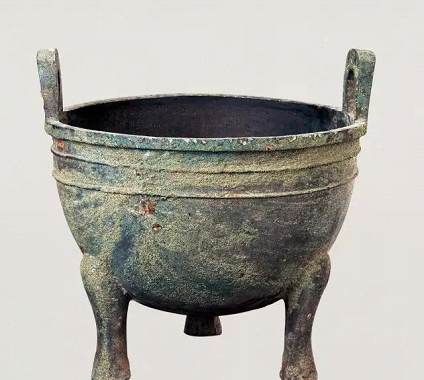
Duoyouding of the Western Zhou Dynasty
Duoyouding was cast in the period of Emperor Li of the Western Zhou Dynasty. The 22 lines of inscription including 279 characters cast inside of the Duoyouding recorded a war fought against the intrusion of Xian Yun (a nationality in ancient China) in the period of Emperor Li in the Western Zhou Dynasty. As an important document in remote times, the inscription has high scientific value for the research of the history of the Xiongnu, a nationality in ancient China, and the politics, economy, military and ethnic relations in the Western Zhou Dynasty. The inscription characters are concise and smooth, writing a significant chapter in the history of Chinese calligraphy and art.


Empress Seal from the Han Dynasty
The Empress Seal is the earliest imperial seal for the Empress of China and the only material object for the research of the imperial seals of the Empress in the Han Dynasty. It is of high value to study the imperial seals belonging to the Empresses and Emperors in the Qin and Han Dynasty. With high historical and artistic value, the seal has been listed as one of the national cultural relics.


Copper censer in the shape of bamboo joints coated with gold and silver from the Han Dynasty
The copper censer in the shape of bamboo joints coated with gold and silver from the Han Dynasty was unearthed in 1981 in the No.1 subordinate tomb of the Maoling Mausoleum located in Xingping county of Shaanxi. It is 58 cm in height, 9 cm in the top diameter, 13.3 cm in the bottom diameter, and 2.57 kg in weight. It is listed as one of the top level cultural relics in China. Burning incense is a custom in ancient China for room cleaning and sometimes for the scent of clothes and quilts. “If you are the Agarwood, then I will be a Boshan censer” is the poetic metaphor for the censer and incense appreciated by scholars in the Han, Jin, Song, Qi, Liang and Chen Dynasties. Among those containers for burning incense, the copper censer in the shape of bamboo joints is one of the most exquisite Boshan censers at that time.
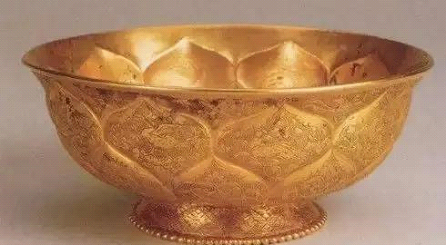
Lotus-petal-shaped Gold Bowl with Mandarin Ducks Pattern 1
Featured with smooth lotus petals, a stable dual structure and gorgeous ornamentation, these two gold bowls represent the typical art style of the Tang Dynasty. It must be noted that its reference to and transformation of western gold and silver wares reflects not only the exchange and integration of Chinese and Western cultures in the Tang Dynasty, but also the innovative spirit of Tang people.

Lotus-petal-shaped Gold Bowl with Mandarin Ducks Pattern 2
Decorated with the flourishing spirit of the times and harmonious aesthetics taste of the people, this pair of gold bowls gives equal emphasis to the whole and the part, the appearance and the implied meaning it conveyed, which serves as a sign of matured decorative art of the Tang Dynasty. It is literally a masterpiece hardly seen today: the multi-layered and high-density ornamentation is clearly engraved in such a limited space in an orderly and accurate manner, representing the best fabrication technique of gold and silver figurines of the Tang Dynasty.

Black-glazed Oil-droplets Bowl
This wide-mouthed black-glazed bowl was originally grey and white with a small bottom, which is covered with small dots of different sizes. These dots glittering with metallic luster look like oil droplets floating on the water, earning the name of “oil-droplets glaze”. The oil-droplets glaze is actually a crystal glaze under the large category of black glaze. This black-glazed oil-droplets bowl is the largest one in size of the same kind of wares so far.

Agate Cup with Inlaid Golden Animal Head from the Tang Dynasty
This agate cup is deep red and orange yellow with milky white agate. With clear layers and beautiful shades of colors, the cup is translucent and bright. The cup’s mouth is inlaid with a cage-shaped gold plug, which can be removed, and the wine can be poured from the cup via the inside channel. This agate cup is not only an extremely rare ancient jade-carved artwork, but also an important reference for us to learn about the cultural exchanges between China and the foreign countries in the Tang Dynasty.
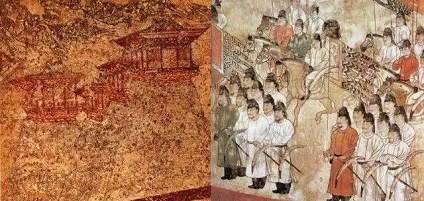
The Honor Guard on the Side Tower Mural from the Tang Dynasty (two sets of pictures)
The Mural of the Side Tower is part of the murals inside the tomb of Prince Yide, which is the largest mural with the most magnificent scene of the Tang Dynasty.

The Mural of Palace Maids from the Tang Dynasty
Unearthed from the tomb of Princess Yongtai of the Tang Dynasty (LiXianhui) located in Qianxian County, Shaanxi Province in 1960, the Mural of the Palace Maids is 179 cm in height and 210 cm in width, and is painted on the east wall of the front room of the tomb. There are a total of 9 people, including 2 female officers and 7 maids with high buns, spiral-shaped buns or dual spiral-shaped buns on the mural. Wearing small-sleeved clothes with the part of body above their chests bared, scarves, long-flowing dresses in red, green, or yellow, and lotus shoes with cloud-shaped decorative patterns, these women hold candlesticks, moon-shaped fans, Ruyi, square boxes, pots, or goblets, moving leisurely and carefree.
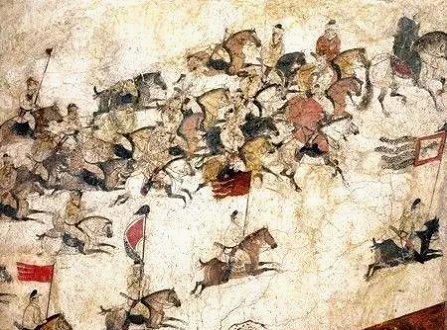
Hunting and Travel Mural from the Tang Dynasty
Excavated from the tomb of Prince Zhanghuai (Lixian) located in Qianxian County, Shaanxi Province in 1971, the mural is approximately 100-200 cm in height and 890 cm in width, which is among the finest murals unearthed from the tombs of the Tang dynasty.
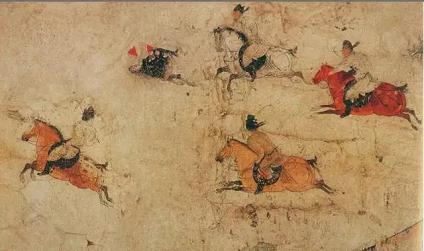
The Mural of Playing Polo of the Tang Dynasty
The mural of playing polo unearthed from Prince Zhanghuai’s Tomb is recognized as a national treasure for its magnificent scene and brilliant composition. The mural represents the earliest image of polo activity.

Silver Wine Jug with a Dancing Horse Pattern from the Tang Dynasty
This cultural relic is a product of the exchange and integration of minority cultures and central plain cultures. Moreover, the fabrication technique of this pot is unique with barely no traces of welding.
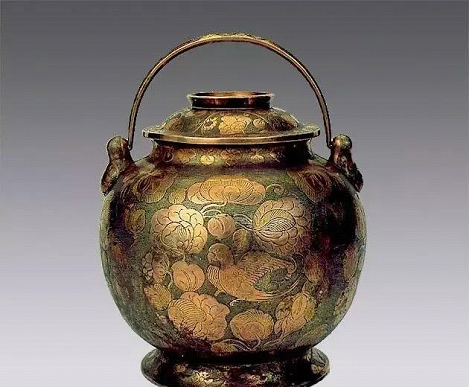
Handled Silver Pot with a Parrot Pattern from the Tang Dynasty
This handled silver pot was half full with water when it was excavated from Hejia village in 1970. A piece of thin gold foil was floating on the water with twelve fine and delicate gold dragons on top of it. Scattering in the water, a dozen of colorful gems were still dazzling after thousands of years.
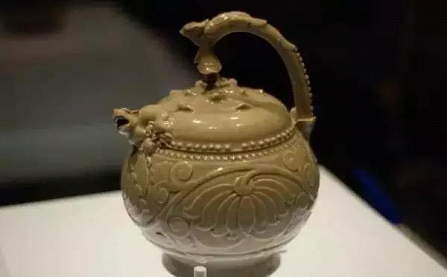
Celadon Bottom-filled-in Kettle with a Loop Handle from the Song Dynasty
As one of the national treasures of the Shaanxi History Museum, the kettle was unearthed in Binxian County, Shaanxi Province in 1968. The kettle is 18.3 cm high with a diameter of 14.3 cm. The handle is shaped like a bending phoenix, and the lid looks like a flower bud. The lid and the kettle are connected with a breastfeeding mother and baby lions with the mother lion’s mouth open as the spout. The ball-shaped body of the kettle is engraved with peony patterns. A plum blossom-shaped water injection hole is at the center of the bottom. This unique design makes it one of the best masterpieces of Yao Kiln Porcelain.
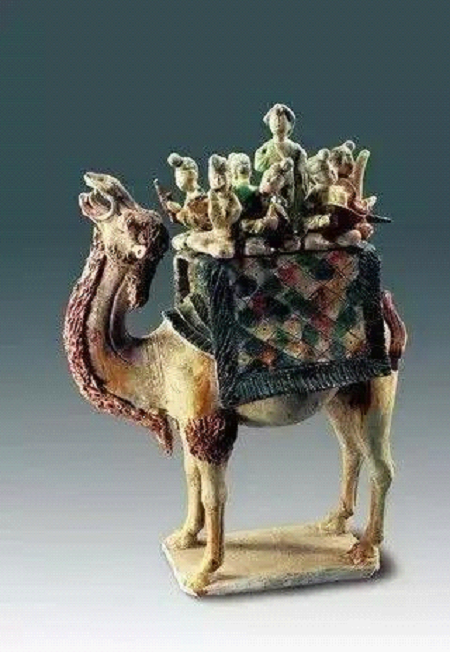
Tri-colored Camel Carrying Musicians on the Back from the Tang Dynasty
This group of music and dance figurine is a typical product of the Tang Dynasty. The dancers wear the clothes of the Han nationality, but play mostly with the instruments from the West, representing the "New Voice of the Hu Region" popular in the Kaiyuan and Tianbao periods, which is a new form of dancing music cultivated after the integration of Hu and Han culture. The color of the glaze is bright and natural. It is among the best tri-color ceramics of the Tang dynasty.


